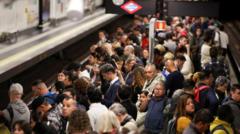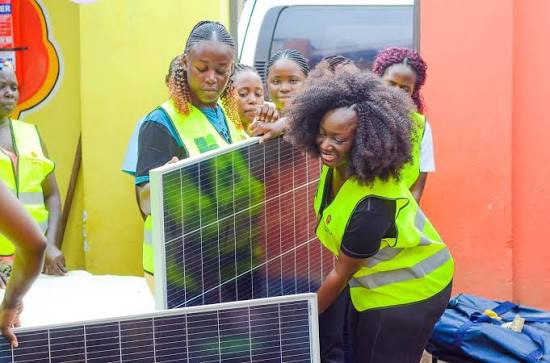As life begins to normalise in Spain and Portugal, many are left pondering what led to the blackout and the steps necessary to avoid such incidents in the future. It was on Tuesday morning, 23 hours after a disastrous system failure, that Spain's electricity grid was declared functional once more. While train services in some areas are still suspended, most households regained power and resumed their daily routines.
Chaos engulfed Spain throughout Monday, primarily attributed to two simultaneous disconnection events in the southwest of the country, alongside a nearly hour-long disconnection from the French electricity network. Prime Minister Pedro Sánchez noted the alarming loss of 15 gigawatts of power at 12:33 PM on Monday, accounting for nearly 60% of the country's power generation at the time. Eduardo Prieto, the operations director for grid operator Red Eléctrica, reported that the system had remained stable until both issues occurred nearly simultaneously in a region highly dependent on solar energy.
Critics are now scrutinizing the country's reliance on renewable energy, particularly solar power, which was responsible for around 60.64% of the energy generation just before the outage. Only the Canary Islands, Balearics, and certain northern African territories remained unaffected.
Despite having a complex energy matrix, the national collapse at 12:35 PM necessitated a colossal response to reinstate power quickly. The grid's recovery targeted both northern and southern generating areas to restore the transmission grid gradually, while ensuring they were not overloaded.
Emphasis was placed on hydroelectric plants and pumped-storage systems due to full reservoirs, allowing for prompt electricity generation. While combined-cycle gas plants contributed to the effort, the blackout resulted in automatic shutdowns of four nuclear reactors, complicating efforts.
Support came from neighboring countries as France and Morocco pitched in, with Morocco transferring 900 MW through cross-Strait lines, and French operator RTE supplying up to 2,000 MW through its interconnectors. By Monday evening, more than a fifth of the power demand in Spain had been restored.
Electricity provider Endesa reported that they managed to reconnect nearly 3.5 million customers by Monday evening, focusing on rebounding hospitals and essential services. By Tuesday morning, 99% of electricity demand was finally restored.
As the nation assesses the aftermath, it estimates the blackout's economic impact could reach €1.6 billion, alongside rising political tensions. Calls for a thorough examination of the government's response arose, but there were also commendations for citizens who adapted, such as using diesel generators in hospitals to maintain vital services and local communities aiding stranded train passengers.
The Spanish police and local authorities stepped up responses, while people in major cities like Madrid and Barcelona adapted to the blackout by using mobile phone torches to navigate public transport systems. Airports also continued operations, albeit running on backup generators.
Despite the significant challenges posed by the blackout, the Spanish government remains committed to addressing infrastructure concerns to mitigate future crises. However, experts warn that the existing systems may struggle to handle the volume of renewable energy being produced, prompting a broader debate on energy strategy and dependency as the nation rebuilds from this massive failure.
Chaos engulfed Spain throughout Monday, primarily attributed to two simultaneous disconnection events in the southwest of the country, alongside a nearly hour-long disconnection from the French electricity network. Prime Minister Pedro Sánchez noted the alarming loss of 15 gigawatts of power at 12:33 PM on Monday, accounting for nearly 60% of the country's power generation at the time. Eduardo Prieto, the operations director for grid operator Red Eléctrica, reported that the system had remained stable until both issues occurred nearly simultaneously in a region highly dependent on solar energy.
Critics are now scrutinizing the country's reliance on renewable energy, particularly solar power, which was responsible for around 60.64% of the energy generation just before the outage. Only the Canary Islands, Balearics, and certain northern African territories remained unaffected.
Despite having a complex energy matrix, the national collapse at 12:35 PM necessitated a colossal response to reinstate power quickly. The grid's recovery targeted both northern and southern generating areas to restore the transmission grid gradually, while ensuring they were not overloaded.
Emphasis was placed on hydroelectric plants and pumped-storage systems due to full reservoirs, allowing for prompt electricity generation. While combined-cycle gas plants contributed to the effort, the blackout resulted in automatic shutdowns of four nuclear reactors, complicating efforts.
Support came from neighboring countries as France and Morocco pitched in, with Morocco transferring 900 MW through cross-Strait lines, and French operator RTE supplying up to 2,000 MW through its interconnectors. By Monday evening, more than a fifth of the power demand in Spain had been restored.
Electricity provider Endesa reported that they managed to reconnect nearly 3.5 million customers by Monday evening, focusing on rebounding hospitals and essential services. By Tuesday morning, 99% of electricity demand was finally restored.
As the nation assesses the aftermath, it estimates the blackout's economic impact could reach €1.6 billion, alongside rising political tensions. Calls for a thorough examination of the government's response arose, but there were also commendations for citizens who adapted, such as using diesel generators in hospitals to maintain vital services and local communities aiding stranded train passengers.
The Spanish police and local authorities stepped up responses, while people in major cities like Madrid and Barcelona adapted to the blackout by using mobile phone torches to navigate public transport systems. Airports also continued operations, albeit running on backup generators.
Despite the significant challenges posed by the blackout, the Spanish government remains committed to addressing infrastructure concerns to mitigate future crises. However, experts warn that the existing systems may struggle to handle the volume of renewable energy being produced, prompting a broader debate on energy strategy and dependency as the nation rebuilds from this massive failure.



















